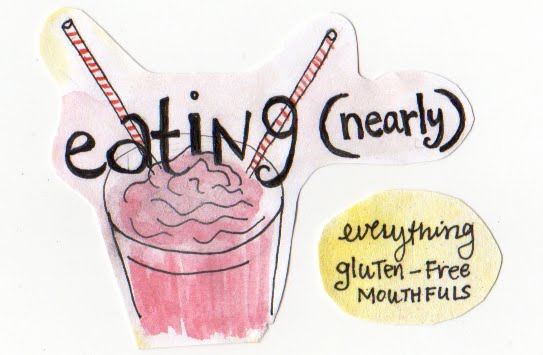 After making a shocking discovery at Whole Foods, I was worried THIS would be the only type of sushi I would be able to eat. I had just gotten used to eating sushi with no soy sauce, happily smothering the rolls in pickled ginger and wasabi—when I discovered barley in the ingredients of a type of bagged ginger at the grocery store. Horror!
After making a shocking discovery at Whole Foods, I was worried THIS would be the only type of sushi I would be able to eat. I had just gotten used to eating sushi with no soy sauce, happily smothering the rolls in pickled ginger and wasabi—when I discovered barley in the ingredients of a type of bagged ginger at the grocery store. Horror!What was I doing, buying pickled ginger at the grocery store? Why, making sushi at home, of course. It's not as easy as it looks. Check out that hideous seaweed monstrosity above!
 We didn't really want to experiment with raw fish, so we used canned tuna. Pictured above is a sort of Italian-Japanese fusion tuna salad; celery, green onion, capers, olive oil, salt and pepper. Sometimes you just have to make do with what you have in the pantry.
We didn't really want to experiment with raw fish, so we used canned tuna. Pictured above is a sort of Italian-Japanese fusion tuna salad; celery, green onion, capers, olive oil, salt and pepper. Sometimes you just have to make do with what you have in the pantry. Brown rice, spread over seaweed! I'm not even going to try to give you hints or tips on this. We ended up eating everything out of a bowl, with seaweed on the side...
Brown rice, spread over seaweed! I'm not even going to try to give you hints or tips on this. We ended up eating everything out of a bowl, with seaweed on the side...  Except for our one precious roll. It took so long to make these little gems we gave up after. Mango! Avocado! And tuna salad. A little pure tamari and you're in good shape.
Except for our one precious roll. It took so long to make these little gems we gave up after. Mango! Avocado! And tuna salad. A little pure tamari and you're in good shape. Anyway, if you have a little more time and some proper instruction, making your own sushi can be fun. [Warning: don't try to do it hungry.] But if you live in New York City—which is to say, with a sushi restaurant on every corner—rest easy, friends. I was determined to get to the bottom of the pickled-ginger-mystery, with a New Year's Resolution of shamelessness burning bright in my heart. I usually hate to be pushy, but I decided it was worth it: I asked the woman at the delivery counter of my local joint [Sushi Tatsu II] if I could please read the ingredients of their pickled ginger. She acquiesced, and the GOOD NEWS IS: it is gluten free.
The BAD NEWS IS: it has aspartame in it. Um, gross? Of course I cannot speak for all sushi restaurants, but I assume most places use the same bulk kind. It comes in an enormous white bucket, like what a young giant might bring to the beach.

No comments:
Post a Comment